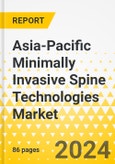1 Markets
1.1 Market Outlook
1.1.1 Market Overview
1.1.2 Product Definition
1.1.3 Inclusion and Exclusion Criteria
1.1.4 Key Findings
1.1.5 Assumptions and Limitations
1.1.6 Market Growth Scenario
1.1.6.1 Realistic Growth Scenario
1.1.6.2 Optimistic Growth Scenario
1.1.6.3 Pessimistic Growth Scenario
1.2 Industry Outlook
1.2.1 Key Trends
1.2.2 Opportunity Assessment
1.2.3 Patent Analysis
1.2.3.1 Awaited Technological Developments
1.2.3.2 Patent Filing Trend (by Country)
1.2.3.3 Patent Filing Trend (by Year)
1.2.4 Product Benchmarking
1.2.5 Clinical Trials
1.3 Impact of COVID-19 on the Minimally Invasive Spine Technologies
1.3.1 Pre-COVID-19 Phase
1.3.2 During COVID-19
1.3.3 Post-COVID-19 Phase
1.3.3.1 Impact on Demand and Supply
1.3.3.2 Impact on Competitive Landscape
1.3.3.3 Impact on Company Revenue
1.4 Business Dynamics
1.4.1 Impact Analysis
1.4.2 Business Drivers
1.4.2.1 Increasing Incidences and Prevalence of Spinal Disorders
1.4.2.2 Increasing Preference for Minimally Invasive Spine Surgeries
1.4.2.3 Technological Advancement in Minimally Invasive Spine Surgical Procedures
1.4.3 Business Restraints
1.4.3.1 Lack of Well-Established Landscape for Reimbursement for Minimally Invasive Spinal Procedures
1.4.3.2 Factors Hindering the Implementation of Minimally Invasive Spinal Surgeries
1.4.3.2.1 High Cost of Capital Equipment Purchases and Disposables
1.4.3.2.2 Lack of Training Leading to Shortage of Skilled Professionals
1.4.4 Business Opportunities
1.4.4.1 Augmentation of Artificial Intelligence in Minimally Invasive Spine Surgery
1.4.4.2 Leveraging Synergies to Diversify Business Portfolio
2 Minimally Invasive Spine Technologies Market (by Region)
2.1 Asia-Pacific
2.1.1 Regulatory Framework
2.1.2 Key Findings and Opportunity Assessment
2.1.3 Market Dynamics
2.1.3.1 Impact Analysis
2.1.4 Market Sizing and Forecast Analysis
2.1.4.1 Asia-Pacific Minimally Invasive Spine Technologies Market (by Country)
2.1.4.1.1 Japan
2.1.4.1.1.1 Market Dynamics
2.1.4.1.1.2 Market Size and Forecast
2.1.4.1.2 China
2.1.4.1.2.1 Market Dynamics
2.1.4.1.2.2 Market Size and Forecast
2.1.4.1.3 Australia
2.1.4.1.3.1 Market Dynamics
2.1.4.1.3.2 Market Size and Forecast
2.1.4.1.4 India
2.1.4.1.4.1 Market Dynamics
2.1.4.1.4.2 Market Size and Forecast
2.1.4.1.5 South Korea
2.1.4.1.5.1 Market Dynamics
2.1.4.1.5.2 Market Size and Forecast
2.1.4.1.6 Rest-of-Asia-Pacific
2.1.4.1.6.1 Market Dynamics
2.1.4.1.6.2 Market Size and Forecast
3 Competitive Benchmarking and Company Profiles
3.1 Competitive Landscape
3.1.1 Key Strategies and Developments
3.1.1.1 Regulatory and Legal Activities
3.1.1.2 New Offerings
3.1.1.3 Mergers and Acquisitions
3.1.1.4 Partnerships, Collaborations, and Business Expansions
List of Figures
Figure 1: Minimally Invasive Spine Surgery Techniques
Figure 2: Asia-Pacific Minimally Invasive Spine Technologies Market, $Million, 2021-2032
Figure 3: Minimally Invasive Spine Technologies Market (by Region), $Million, 2022 and 2032
Figure 4: Minimally Invasive Spine Technologies Market, Market Dynamics
Figure 5: Minimally Invasive Spine Technologies Market: Research Methodology
Figure 6: Primary Research
Figure 7: Secondary Research
Figure 8: Bottom-Up Approach (Segment-Wise Analysis)
Figure 9: Top-Down Approach (Segment-Wise Analysis)
Figure 10: Assumptions and Limitations
Figure 11: Minimally Invasive Spine Technologies Market Size and Growth Potential (Realistic Growth Scenario), $Million, 2021-2032
Figure 12: Minimally Invasive Spine Technologies Market Size and Growth Potential (Optimistic Scenario), $Million, 2021-2032
Figure 13: Minimally Invasive Spine Technologies Market Size and Growth Potential (Pessimistic Scenario), $Million, 2021-2032
Figure 14: Minimally Invasive Spine Technologies Market, Key Trends
Figure 15: Minimally Invasive Spine Technologies Market, Key Trends, Market Shift, 2022-2032
Figure 16: Minimally Invasive Spine Technologies Market, Patent Analysis (by Country), January 2018-January 2023
Figure 17: Minimally Invasive Spine Technologies Market, Patent Analysis (by Year), January 2018-January 2023
Figure 18: Minimally Invasive Spine Technologies Market, Impact Analysis
Figure 19: Incidence of Degenerative Spine Disease, by Region, 2018
Figure 20: Geriatric Population Growth, by Region, 2019 vs. 2050
Figure 21: Prevalence of Spinal Degeneration (by Age), 2021
Figure 22: Next-Generation Products for Minimally Invasive Spine Surgery
Figure 23: Relative Comparison of Operative Factors in 2-Dimensional Versus 3-Dimensional Minimally Invasive Spine Surgery
Figure 24: Cost of Robotic-Assisted Systems Used in Spine Surgery
Figure 25: Artificial Intelligence Improving the Quality and Delivery of Care
Figure 26: Minimally Invasive Spine Technologies Market Share (by Region), 2021 and 2032
Figure 27: Asia-Pacific Minimally Invasive Spine Technologies Market Incremental Opportunity (by Country), $Million, 2021-2032
Figure 28: Asia-Pacific Minimally Invasive Spine Technologies Market, $Million, 2021-2032
Figure 29: Asia-Pacific Minimally Invasive Spine Technologies Market (by Country), % Share, 2021 and 2032
Figure 30: Japan Minimally Invasive Spine Technologies Market, $Million, 2021-2032
Figure 31: China Minimally Invasive Spine Technologies Market, $Million, 2021-2032
Figure 32: Australia Minimally Invasive Spine Technologies Market, $Million, 2021-2032
Figure 33: India Minimally Invasive Spine Technologies Market, $Million, 2021-2032
Figure 34: South Korea Minimally Invasive Spine Technologies Market, $Million, 2021-2032
Figure 35: Rest-of-Asia-Pacific Minimally Invasive Spine Technologies Market, $Million, 2021-2032
Figure 36: Share of Key Developments and Strategies, January 2018-January 2023
Figure 37: Regulatory and Legal Activities, January 2018-January 2023
Figure 38: New Offerings, January 2018-January 2023
Figure 39: Mergers and Acquisitions, January 2018-January 2023
Figure 40: Partnerships, Alliances, and Business Expansions, January 2018-January 2023
List of Tables
Table 1: Key Challenges and Possible Solutions for Players in the Minimally Invasive Spine Technologies Market
Table 2: Minimally Invasive Spine Technologies Market, Quarterly Key Developments Analysis, January 2018-January 2023
Table 3: Key Questions Answered in the Report
Table 4: Parameters for Realistic, Optimistic, and Pessimistic Growth Scenarios
Table 5: Minimally Invasive Spine Technologies Market, Awaited Technologies
Table 6: Minimally Invasive Spine Technologies Market, Product Benchmarking
Table 7: Minimally Invasive Spine Technologies Market, Ongoing Clinical Trials
Table 8: Asia-Pacific Minimally Invasive Spine Technologies Market, Regulatory Framework
Table 9: Asia-Pacific Minimally Invasive Spine Technologies Market, Impact Analysis








